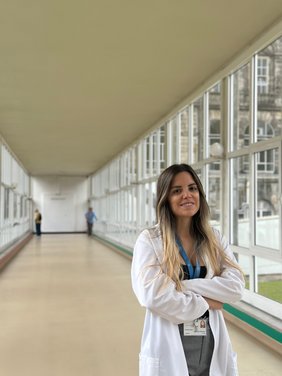US Quantification of Liver Fat: Past, Present, and Future
David T Fetzer, Theodore T Pierce, Michelle L Robbin, Guy Cloutier, Arjmand Mufti, Timothy J Hall, Anil Chauhan, Reinhard Kubale, An Tang
Radiographics. 2023 Jul;43(7):e220178. doi: 10.1148/rg.220178
Hepatic steatosis is a growing public health problem with crescent clinical impact and associated medical costs and Non-alcoholic fatty liver disease (NAFLD) is now the most common cause of chronic hepatopathy worldwide. [1]
This article focuses on the urgent need to find a method capable of detecting and quantifying liver fat that is reliable, reproducible, non-invasive and accessible to the general population.
US is a widely availability and non-invasive method and manufactures have been working in the devolvement of quantitative software to overcome the subjective evaluation of hepatic steatosis using the classical B-mode. This classic approach is not sensitive enough, especially when liver fat content is less than 20% and in patients with obesity or renal disease. [2,3]
The authors begin by praising the role of MRI proton-density fat fraction as the most accurate non-invasive biomarker of hepatic steatosis. However, MRI is not widely available for screening and surveillance of the general population, which becomes quite limiting taking into account the dimension and prevalence of this pathology. [4]
The article focuses especially on methods that use ultrasound to evaluate hepatic steatosis, emphasizing the limitations and advantages of each technique.
A non-image-guided technique, the Controlled Attenuation Parameter (CAP), is only available in vibration-controlled transient elastography (VCTE) devices and it is widely available. Nevertheless, it is a non-image-guided method and therefore does not allow avoiding masses, vessels and other possible artefacts. Furthermore, it is not a reliable method in the presence of ascites, obesity and in the presence of steatohepatitis and fibrosis.
The qualitative assessment of steatosis by ultrasound has been carried out since 1970 and is based on the assessment of the echogenicity of the liver and the comparison with the echogenicity of the right kidney and pancreas as well as the conspicuity of the portal vessels, gallbladder walls and diaphragm-lung interface. However, this method is subjective and does not allow the severity of the stenosis to be quantified, making it difficult to follow these patients over time.
The hepatorenal index is a semiquantitative method that is calculated by dividing the ROI of the liver parenchyma and the right renal cortex. This method is reproducible and intuitive; nevertheless, it is operator-dependent and there are no established cut-offs. Furthermore, it demands the presence of a normal kidney.
The attenuation coefficient, backscatter coefficient and speed of sound are other recently introduced methods that allow a quantitative assessment of steatosis.
The attenuation coefficient is a relatively intuitive and reproducible method that quantifies the acoustic energy that is lost when crossing the liver parenchyma. [5]
In turn, backscatter coefficient measures ultrasound echoes generated by reflection and scattering, which determine the brightness in the image generated in B-Mode.
Finally, Speed of Sound is influenced by the stiffness and the density of the liver and is inversely correlated with steatosis.
These three methods can be confounded by several factors such as near-field reverberation artefacts, liver heterogeneity or fibrosis.
More recently, a promising technique has emerged - modeling phantom-corrected attenuation and backscatter—which combines the attenuation coefficient and the backscatter coefficient, thus reducing possible sources of variability. This technique has demonstrated a linear correlation with MRI-PDFF. The need for a large ROI (3 cm) might be a limitation of this method, as these measurements may be affected by the presence of liver masses and the non-homogeneous distribution of steatosis. [6]
At the end of the paper, the authors give us a glimpse of what the future holds in this matter, highlighting evolving techniques such as radiofrequency envelope analysis and artificial intelligence–based techniques. They also highlight the role of multiparametric modeling that takes into account the various conditions that can affect the liver, like inflammation and fibrosis, improving the diagnostic performance in this setting.
References:
[1] Giovanna Ferraioli and Livia Beatriz Soares Monteiro. Ultrasound-based techniques for the diagnosis of liver steatosis. World J Gastroenterol. 2019 Oct 28; 25(40):6053-6062. DOI: 10.3748/wjg.v25.i40.6053
[2] Yu-Tian Cao, Liu-Lan Xiang, Fang Qi, Yu-Juan Zhang, et al. Accuracy of controlled attenuation parameter (CAP) and liver stiffness measurement (LSM) for assessing steatosis and fibrosis in non-alcoholic fatty liver disease: A systematic review and meta-analysis. EClinicalMedicine. 2022 Jul 10;51:101547. DOI: 10.1016/j.eclinm.2022.101547
[3] Laurent Castera, Mireen Friedrich-Rust, Rohit Loomba. Noninvasive Assessment of Liver Disease in Patients With Nonalcoholic Fatty Liver Disease. Gastroenterology. 2019 Apr;156(5):1264-1281.e4. DOI: 10.1053/j.gastro.2018.12.036
[4] Jiulian Gu, Shousheng Liu et al. Diagnostic value of MRI-PDFF for hepatic steatosis in patients with non-alcoholic fatty liver disease: a meta-analysis. Eur Radiol. 2019 Jul;29(7):3564-3573. DOI: 10.1007/s00330-019-06072-4
[5] Marco Dioguardi Burgio, Maxime Ronot et al. Quantification of hepatic steatosis with ultrasound: promising role of attenuation imaging coefficient in a biopsy-proven cohort. Eur Radiol. 2020 Apr;30(4):2293-2301. DOI: 10.1007/s00330-019-06480-6
[6] Riccardo De Robertis, Flavio Spoto, et al. Ultrasound-derived fat fraction for detection of hepatic steatosis and quantification of liver fat content. Radiol Med. 2023 Aug 12. DOI: 10.1007/s11547-023-01693-8
Dr. Adriana Silva is a second-year radiology resident at the Centro Hospitalar Universitário do Porto, in Portugal. She has a wide range of interests in diagnostic imaging including abdominal and gastrointestinal radiology.
Comments may be sent to adrianamane360(at)gmail.com


